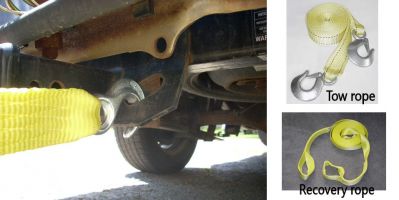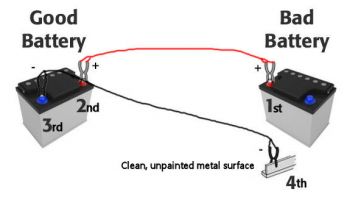Main > Automotive > Mechanics > Panel Beating
Rear panel damage: If someone does substantial damage to your rear-end, such that unremovable panels (quarter, beaver, boot floor, chassis rail panels) are irrepairable, here's what to do. Find a wrecker who will give you a "rear cut" of the same model car as yours, and preferably the same colour. They will use oxyacetylene to sever the whole back of a car (from across the back seat) which you can deliver with a trailer to a panel beater so they have the (expensive or discontinued) panels they need to fix your car.
Be sure your panel beater is for this option however and check their charges for removing individual panels from the rear cut. It will need to have spot welds removed as well as some mechanical work (removal from the rear axle etc).
When transporting the rear half of the car, it will have its rear axle, rear muffler and shocks/disc rotors/calipers still connected to it. You can use a trailer but the width will mean the rear cut sits on top of the trailers sides. Use a set of four ratchet straps to secure it for the deilvery.
Try to remove (and later refit) as much of the trim, lights, bumper/tow bars and other fittings as you can as part of your repair with the panel beater. It can save over a thousand dollars off your quote alone if you do this yourself with their prior agreement.
myxlfidian (150)
|
|
|
Main > Automotive > Mechanics > Write-offs (repair or destroy?)
Rear panel damage: If someone does substantial damage to your rear-end, such that unremovable panels (quarter, beaver, boot floor, chassis rail panels) are irrepairable, here's what to do. Find a wrecker who will give you a "rear cut" of the same model car as yours, and preferably the same colour. They will use oxyacetylene to sever the whole back of a car (from across the back seat) which you can deliver with a trailer to a panel beater so they have the (expensive or discontinued) panels they need to fix your car.
Be sure your panel beater is for this option however and check their charges for removing individual panels from the rear cut. It will need to have spot welds removed as well as some mechanical work (removal from the rear axle etc).
When transporting the rear half of the car, it will have its rear axle, rear muffler and shocks/disc rotors/calipers still connected to it. You can use a trailer but the width will mean the rear cut sits on top of the trailers sides. Use a set of four ratchet straps to secure it for the deilvery.
Try to remove (and later refit) as much of the trim, lights, bumper/tow bars and other fittings as you can as part of your repair with the panel beater. It can save over a thousand dollars off your quote alone if you do this yourself with their prior agreement.
myxlfidian (150)
|
|
|
Main > Automotive > Driving > Safety
GPS: It's handy to have a Global Positioning System in your car (they're not that expensive nowadays) for a number of reasons:
There's nothing more dangerous than not knowing where you're going, or trying to read maps while you're driving.
If you or someone else breaks down, or has an accident, or needs medical attention, it will have a function which tells you exactly where you are, making it easy to report your exact location over the phone.
Some GPS units can warn you if you're driving too fast, or are near a school.
Kevin Solway (173)
|
|
|
Main > Automotive > Economy
GPS: Use a GPS (Global Positioning System) unit to preview different routes to your destination, so that you can find the shortest, or fastest and most economical route.
Kevin Solway (173)
|
|
|
Main > Automotive > Mechanics > Panel Beating
Older cars and smashes: Cars older than 15 years almost always have rust in structural panels underneath the painted panels you see on the outside of the car. These inner panels have never had the same level of protection given the outer panels. However, the level of rust will almost never be significant enough to cause rips or broken sections on its own. Combine this age of car with even a moderate smash however, and you may be surprised to see parts of these inner panels with large rips in them when the damaged outer panels are removed. The combination of rust and impact rips gaps in inner (and outer) panels that would have lasted untreated for decades without that kind of brute force.
myxlfidian (150)
|
|
|
Main > Automotive > Selling
If you have a hanging car air freshener that's almost dead, reinvigorate it by adding a few drops of eucalyptus oil.
kellyjones00 (593)
|
|
|
Main > Automotive > Buying
Always compare the price of a new or used car with a reliable independent motor vehicle evaluation guide. Examples in australia: for a private sale, look at redbook.com.au, and for a licensed car dealer look at glassguide.com.au
kellyjones00 (593)
|
|
|
Main > Automotive > Buying
When comparing used vehicles, a good rule of thumb is to buy newer models with an odometer reading of under 130,000 klms. Most new car warranties expire then.
kellyjones00 (593)
|
|
|
Main > Automotive > Buying
Check whether there are any loans owing on an used vehicle, or whether it's security for another loan, by entering the registration, VIN, and engine number into an online registration check like REVS. Get a clear REVS certificate (if possible) less than 24 hours before you sign the contract and take the keys. This is a guarantee against the car being repossessed.
kellyjones00 (593)
|
|
|
Main > Automotive > Buying
Don't do any test drives until after a thorough inspection of the car. Look at a number of automobile club or car insurance websites to find a good checklist.
kellyjones00 (593)
|
|
|
Main > Automotive > Buying
After you have found a candidate for purchase, have an independent mechanic do a thorough inspection and create a report. if the seller requires a holding deposit (e.g. 10%) then get a receipt stating "the holding deposit is refundable if the mechanical inspection is dissatisfactory to the buyer."
kellyjones00 (593)
|
|
|
Main > Automotive > Buying
After the inspection, ask the seller for any repairs to be done before getting to the point of sale. Also ask for things like floor mats or wheel alignments to be done.
kellyjones00 (593)
|
|
|
Main > Automotive > Buying
In some states, a licensed car dealer must offer a statutory warranty for a used car if it has done less than 120,000 - 150,000 kilometers or is under 7-10 years old. Otherwise, you may be able to purchase a reasonable warranty, but the dealer will probably require all services to be done by them.
kellyjones00 (593)
|
|
|
Main > Automotive > Buying
There is no warranty for used cars sold privately.
kellyjones00 (593)
|
|
|
Main > Automotive > Buying
At the point of sale, negotiation is expected. Say, "I'm offering $....." then be silent. If the salesperson gets up to talk to their manager, you should get up too, to show you're not attached to the deal.
You could also mention the cost of various repairs not done as justification for lowing the price.
If the seller reduces their price, raise your offer by a smaller increment than they've reduced by. If they say they're losing money, say that your budget is your concern.
kellyjones00 (593)
|
|
|
Main > Automotive > Buying
Read the contract carefully. Don't sign unless you agree with everything. Make sure any promises mentioned earlier are in writing. For instance, "faulty number plate globes replaced".
kellyjones00 (593)
|
|
|
Main > Automotive > Buying
When test-driving the car, make sure you are covered by insurance in case of an accident. You may have to pay an excess.
kellyjones00 (593)
|
|
|
Main > Automotive > Buying
Wait until you have car insurance before taking the keys or driving the car home. Read reviews of different insurance companies: the cost and features of a policy is not as important as the actual behaviour of the company in the case of claims.
kellyjones00 (593)
|
|
|
Main > Automotive > Mechanics > Headlights/Taillights
If the headlights don't work, check the fuses and fusible links in the fuse box in the engine compartment. If these look fine, the problem is either wiring or the switch itself. To replace the switch, remove the steering column cover, pull out the electric connector plug, and unscrew the switch.
kellyjones00 (593)
|
|
|
Main > Automotive > Driving
Don't drive either drunk or tired. If you do, you are guaranteed to come to grief.
thesource (378)
|
|
|
Main > Automotive > Driving
Take "40 winks" for fifteen minutes or so if you are feeling tired. It will make a world of difference. Not only will you avoid having an accident, but you will enjoy your driving more once you are rested.
thesource (378)
|
|
|
Main > Automotive > Driving
Don't speed. The small amount of time you will save will be far outweighed by the increased chance of an accident. It doesn't matter how good a driver you are because not everyone on the road is a good driver, and they will be more likely to run into you.
thesource (378)
|
|
|
Main > Automotive > Driving
Don't fiddle with electronic devices, such as GPSs or phones, while driving. Pull over and do what you have to do, before you continue driving.
thesource (378)
|
|
|
Main > Automotive > Driving
Use a GPS unit if you are unfamiliar with the roads. They are a lot safer than using a folding map.
thesource (378)
|
|
|
Main > Automotive > Driving
Keep your eyes on the distance to see what is coming up, and anticipate any problems or actions you will need to take. You should be able to see close objects using your peripheral vision.
thesource (378)
|
|
|
Main > Automotive > Driving
Wear your seat belt. You don't want to be thrown through the windshield.
thesource (378)
|
|
|
Main > Automotive > Driving
Drive more slowly in bad weather or when the road surface is poor. The speed limits don't apply when conditions are bad.
thesource (378)
|
|
|
Main > Automotive > Driving
Brakes and tires. Make sure they are in good condition. If your tires have a low pressure then you will have poor handling, and fast braking is important in an emergency.
thesource (378)
|
|
|
Main > Automotive > Driving
Listening to music might be relaxing, but research suggests that it decreases your reaction times.
thesource (378)
|
|
|
Main > Automotive > Driving
If you get stuck in mud, sand, or snow don't use a tow rope or recovery rope or strap unless you really need to, because they are dangerous, even for those who are trained in how to use them. It's best to use a professional towing company. But if you have to use a rope, then:
- Don't use a tow rope for vehicle recovery (ie, pulling a car out of mud, sand, or a hole). Tow ropes are not designed to stretch much, and so are not designed for this job. Only specially designed recovery straps are suitable for such tasks. Tow ropes are only designed for pulling cars along normal surfaces. Tow ropes have dangerous hooks on the end, and if they come loose, they can, and do kill people.
- Move everyone who doesn't need to be there well away from the area because people have been killed when hooks on the ends of the rope go flying at very high speed.
- Use a rope of the correct strength for the vehicle you are pulling
- Attach the ends to the appropriate strong points on the chassis of the vehicle
- Hooks should be attached so that the strong part of the hook is engaged, and so it is less likely to fall off.
- Don't attempt to attach the rope to a tow ball. It's not strong enough, and nor is it designed for the purpose. The rope can fly off, or the tow ball itself can go flying.
- A person needs to be driving the vehicle being towed. If being towed, turn the ignition key to the accessory position to turn off the steering lock. Also, turn off the handbrake, and put the transmission in neutral. [Or if being recovered out of a hole, you will trying to drive out in first gear.]
- If the power steering is not working, it's best not to attempt to tow the vehicle, as driving it can be dangerous.
- Don't tow a car backwards. Both cars must be going forwards.
- Go easy when you pull, starting very slowly, and don't go fast.
- When being pulled, the rope must always be taut. The vehicle being towed should carefully brake at the same time as the towing vehicle.
- Don't pull the vehicle any further than you have to.
- If towing a vehicle along a road, you should place a sign on the back of the vehicle being towed, saying "On tow".
thesource (378)

Click to enlarge
|
|
|
Main > Automotive
Jump-start a car:
Begin by turning off both cars.
1. Connect the red (+ve) jumper cable to the positive terminal of the flat battery.
2. Connect the other end of the red (+ve) jumper cable to the positive terminal of the good battery.
3. Connect the black (-ve) jumper cable to the negative terminal of the good battery.
4. Connect the other end of the black (-ve) jumper cable to a clean, unpainted metal surface under the disabled vehicle’s hood.
5. Start the vehicle that’s not disabled and run it for 2 to 3 minutes allowing the battery of the disabled car to charge.
6. Now try to start the disabled vehicle.
7. Disconnect the jumper cables in reverse order.
thesource (378)

Click to enlarge
|
|
|
Main > Automotive > Driving
Driving in fog:
- Use low beam. Using high beam will only light up the fog in front of the car, making it more difficult to see.
- Drive more slowly.
- Open the windows slightly, and listen for traffic.
- Use the line on the side of the road to guide you. Do not use the center line.
- Yellow-tinted sunglasses, used during the day (not at night), may help to increase contrast, and help you to see the line on the side of the road.
thesource (378)
|
|
|
Main > Automotive > Mechanics
How to avoid getting ripped off by a car mechanic:
- Do your own car services.
- Or, if you can't do all repairs, at least do easy tasks like renewing spark plugs, engine air filter, and fuses.
- Or, if you can't do easy tasks, take a clear detailed photo of the installed items, before asking the mechanic to change them. Then you have proof if the item has been replaced or not.
kellyjones00 (593)
|
|
|
Main > Automotive > Driving
Always turn the overdrive off on the gearshift in an automatic when driving under 70km/h. It saves your gearbox and helps to grip the road better at lower speeds.
myxlfidian (150)
|
|
|
